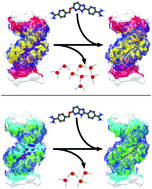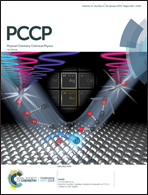Small molecule binders recognize DNA microstructural variations via an induced fit mechanism†
Abstract
Regulation of gene-expression by specific targeting of protein–nucleic acid interactions has been a long-standing goal in medicinal chemistry. Transcription factors are considered “undruggable” because they lack binding sites well suited for binding small-molecules. In order to overcome this obstacle, we are interested in designing small molecules that bind to the corresponding promoter sequences and either prevent or modulate transcription factor association via an allosteric mechanism. To achieve this, we must design small molecules that are both sequence-specific and able to target G/C base pair sites. A thorough understanding of the relationship between binding affinity and the structural aspects of the small molecule–DNA complex would greatly aid in rational design of such compounds. Here we present a comprehensive analysis of sequence-specific DNA association of a synthetic minor groove binder using long timescale molecular dynamics. We show how binding selectivity arises from a combination of structural factors. Our results provide a framework for the rational design and optimization of synthetic small molecules in order to improve site-specific targeting of DNA for therapeutic uses in the design of selective DNA binders targeting transcription regulation.



 Please wait while we load your content...
Please wait while we load your content...